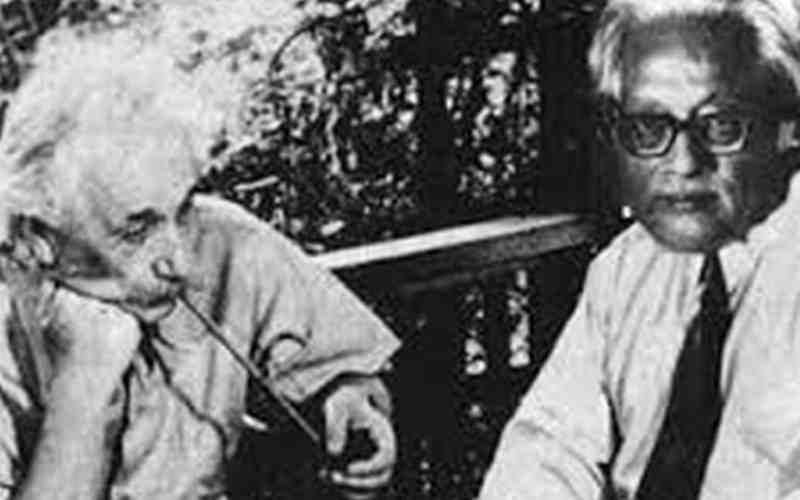
বহু দিন ধ’রে বহু ক্রোশ দূরে
বহু ব্যয় করি বহু দেশ ঘুরে
দেখিতে গিয়েছি পর্বতমালা,
দেখিতে গিয়েছি সিন্ধু।
দেখা হয় নাই চক্ষু মেলিয়া
ঘর হতে শুধু দুই পা ফেলিয়া
একটি ধানের শিষের উপরে
একটি শিশিরবিন্দু।
– রবীন্দ্রনাথ ঠাকুর (স্ফুলিঙ্গ হতে সংগ্রহীত)
Table of Contents
Introduction
Early Life and Academic Journey of Prof. S.N. Bose
Bose's Pioneering Work in Quantum Mechanics
3.1. Derivation of Bose-Einstein Statistics
3.2. Collaboration with Albert Einstein
Bose-Einstein Theory: Foundations and Implications
4.1. Quantum Statistics: Bosons vs. Fermions
4.2. Predictions and Experimental Validations
Boson Particles: Characteristics and Significance
5.1. Definition and Fundamental Properties
5.2. Role in Particle Physics and the Standard Model
Bose-Einstein Condensate (BEC): A New State of Matter
6.1. Theoretical Prediction and Conceptual Framework
6.2. Experimental Realizations and Nobel Recognition
Impact of Bose-Einstein Theory on Modern Physics
7.1. Advances in Quantum Mechanics and Statistical Physics
7.2. Applications in Technology and Material Science
Legacy of Prof. S.N. Bose
8.1. Honors and Recognitions
8.2. Influence on Future Generations of Physicists
Conclusion

A Journey into Quantum Realms
Prof. Satyendra Nath Bose (SN Bose), one of the foremost minds in theoretical physics, profoundly transformed our understanding of quantum mechanics. His remarkable collaboration with Albert Einstein led to the formulation of Bose-Einstein statistics, which fundamentally shifted our grasp of statistical physics and the nature of subatomic particles. Bose’s theoretical work did not merely remain in the realm of thought experiments; it became the foundation for the discovery of one of the most enigmatic states of matter—Bose-Einstein Condensates. Further, Bose’s pioneering concepts laid the groundwork for the identification of a new class of subatomic particles—Boson—which are vital in the grand framework of the universe. This article explores the life, contributions, and monumental impact of Prof. S.N. Bose, diving deeply into the profound implications of the Bose-Einstein theory and the importance of boson particles in shaping modern physics.
1. Introduction
In the vast expanse of the quantum world, where the rules governing macroscopic reality dissolve into mysterious probabilities and wave-particle dualities, the contributions of certain individuals stand out for their transformative insights. Among these individuals, Satyendra Nath Bose holds a place of reverence. His work at the intersection of quantum mechanics and statistical physics, particularly his collaboration with the towering figure of Albert Einstein, yielded profound insights that challenged and expanded the boundaries of human knowledge.
The Bose-Einstein theory, which arose from this collaboration, not only deepened our understanding of the microscopic behaviour of particles but also introduced concepts that would later find practical application in fields ranging from particle physics to cosmology. Central to this theory is the identification of a new class of particles, Boson, which obey a distinct set of statistical rules and are responsible for some of the most remarkable quantum phenomena known today. This article offers an in-depth exploration of the journey that led to these revolutionary discoveries and the far-reaching implications for modern physics.
2. Early Life and Academic Journey of Prof. S.N. Bose
The story of Satyendra Nath Bose is one of perseverance, curiosity, and intellectual rigour. Born on January 1, 1894, in Kolkata (then Calcutta), India, Bose’s early years were shaped by a burgeoning enthusiasm for mathematics and the natural sciences. His father, Surendranath Bose, a civil servant, supported his intellectual growth by encouraging the young Satyendra to explore the world of numbers and natural laws.
At an early age, Bose was recognized for his exceptional mathematical abilities. His education began at Hindu School in Kolkata, and later he attended Presidency College, where his profound interest in physics flourished. Bose was a student during a golden age of Indian intellectual history, studying alongside other future luminaries, including Meghnad Saha, with whom he would later collaborate on theoretical physics problems.
After completing his undergraduate studies, Bose pursued an advanced degree in theoretical physics at the University of Calcutta. During this period, Bose became deeply fascinated by the emerging field of quantum mechanics, a discipline that was transforming the way scientists understood the subatomic world. Despite facing the limitations imposed by the colonial educational system of British India, Bose’s passion for knowledge drove him forward, and he eventually secured a teaching position at the University of Dhaka, where his groundbreaking work would begin.
3. Bose's Pioneering Work in Quantum Mechanics
3.1. Derivation of Bose-Einstein Statistics
Bose’s entry into the annals of quantum mechanics came with a seemingly straightforward problem—deriving Planck’s law for black-body radiation. However, it was Bose’s approach to this challenge that would revolutionize the field. At the time, Max Planck’s law had already been established as the correct description of black-body radiation, but the underlying statistical mechanics remained elusive.
In 1924, while working as a professor in Dhaka, Bose set out to derive Planck’s law using an entirely new statistical method. He hypothesized that photons, the particles of light, should be treated as indistinguishable entities—a radical departure from classical statistical mechanics, which treated particles as distinguishable individuals. By treating photons as indistinguishable and utilizing a new way to count the possible quantum states these photons could occupy, Bose arrived at a formulation of quantum statistics that differed from the established Fermi-Dirac statistics used for fermions.
This new statistical approach explained why photons could be "bunched" together into the same quantum state, a concept that had not been considered in classical physics. It suggested that under certain conditions, a large number of identical particles could occupy the same state simultaneously—a phenomenon that would become foundational for understanding phenomena like lasers and superconductors.
3.2. Collaboration with Albert Einstein
Excited by his results, Bose sent his paper on photon statistics to Albert Einstein in 1924, accompanied by a letter. Despite its originality, Bose’s paper faced publication challenges, as his ideas were so unconventional that they bewildered many of his contemporaries. However, Einstein immediately recognized the profound significance of Bose’s work. Not only did Einstein translate the paper into German and submit it to the prestigious journal Zeitschrift für Physik, but he also extended Bose’s ideas to material particles, laying the foundation for what would later be called Bose-Einstein statistics.
Einstein realized that the same statistical rules Bose had applied to photons could be extended to atoms or molecules under certain conditions. This marked the birth of the concept of a Bose-Einstein Condensate (BEC)—a new state of matter that arises when particles occupy the same quantum state, resulting in macroscopic quantum phenomena. The collaboration between Bose and Einstein proved to be one of the most intellectually fruitful partnerships in the history of modern physics.
4. Bose-Einstein Theory: Foundations and Implications
4.1. Quantum Statistics: Boson vs. Fermion
At the core of the Bose-Einstein theory lies the classification of subatomic particles into two distinct categories: Boson and Fermion. This distinction is based on the particles' intrinsic quantum properties, particularly their spin. Bosons, named in honour of Bose, possess integer values of spin (0, 1, 2, etc.), while fermions have half-integer spins (1/2, 3/2, etc.).
This seemingly simple difference in spin leads to vastly different behaviours. Fermions, which include particles like electrons and protons, obey the Pauli exclusion principle, meaning no two fermions can occupy the same quantum state simultaneously. This principle is the reason for the structure of the periodic table and the stability of matter, as electrons fill discrete energy levels around the nucleus of an atom.
In contrast, Boson does not obey the Pauli exclusion principle. Instead, multiple Boson can occupy the same quantum state, leading to phenomena where large groups of particles act coherently as a single quantum entity. This behaviour is exemplified in lasers, where photons (which are Boson) all occupy the same quantum state, producing a beam of light with a single frequency and phase.
The statistical treatment that Bose and Einstein developed for Boson, known as Bose-Einstein statistics, describes the distribution of Boson over energy states in thermal equilibrium. One of the key predictions of this theory is that at very low temperatures, a significant fraction of Boson will occupy the lowest possible energy state, leading to the formation of a Bose-Einstein Condensate.
4.2. Predictions and Experimental Validations
The Bose-Einstein theory was revolutionary not only because it provided a new way to think about particle statistics, but also because it predicted a phenomenon that had never been observed before—the Bose-Einstein Condensate. This new state of matter, where particles collapse into the same quantum state and behave as a collective entity, was initially a theoretical construct. For decades, it remained a tantalizing but unverified idea, as the technology required to cool particles to near absolute zero temperatures was not yet available.
However, in the 1990s, advances in cooling techniques allowed physicists to experimentally realize a Bose-Einstein Condensate for the first time. In 1995, physicists Eric Cornell and Carl Wieman at the University of Colorado, along with Wolfgang Ketterle at MIT, successfully created a Bose-Einstein Condensate using rubidium atoms. By cooling the atoms to temperatures just a few billionths of a degree above absolute zero, they were able to observe the atoms collapse into a single quantum state, behaving as if they were a single "super-atom." This groundbreaking achievement earned Cornell, Wieman, and Ketterle the Nobel Prize in Physics in 2001 and confirmed the predictions of Bose and Einstein made almost seventy years earlier.
5. Boson Particles: Characteristics and Significance
5.1. Definition and Fundamental Properties
Bosons, the particles that follow Bose-Einstein statistics, are fundamental to the workings of the universe. Their key characteristic is their integer spin, which differentiates them from fermions and allows them to occupy the same quantum state. This property gives rise to collective quantum phenomena such as superfluidity, superconductivity, and Bose-Einstein Condensation.
In addition to photons, many of the force-carrying particles in the universe are Bosons. These include:
Photons: The particles of light and the mediators of electromagnetic forces.
Gluons: Responsible for mediating the strong nuclear force that holds atomic nuclei together.
W and Z Bosons: Mediators of the weak nuclear force, which is responsible for radioactive decay and other nuclear processes.
Higgs Boson: A particle predicted by the Standard Model and experimentally confirmed in 2012 at CERN's Large Hadron Collider (LHC). The Higgs boson is responsible for giving mass to other particles through the Higgs mechanism.
These Bosonic particles are essential to the framework of the Standard Model of particle physics, which describes how the fundamental forces of nature operate.
6. Conclusion
Prof. Satyendra Nath Bose’s contributions to theoretical physics have had a profound and lasting impact on our understanding of the quantum world. His work with Einstein on Bose-Einstein statistics not only provided a new way to think about the behaviour of particles but also laid the foundation for the discovery of new states of matter and fundamental particles. Bosons, the class of particles that bear his name, play a critical role in the fundamental forces that govern the universe, and the discovery of the Bose-Einstein Condensate opened up new realms of research in quantum mechanics.
Bose's legacy is not merely confined to academic papers or scientific discoveries. His work has inspired generations of physicists to explore the mysteries of the quantum world, and his name remains synonymous with one of the most intriguing and challenging areas of modern physics. As we continue to push the boundaries of our understanding of the universe, the insights provided by Bose and Einstein will undoubtedly continue to shape the course of scientific discovery.



Comments